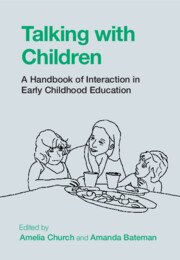Book contents
- Talking with Children
- Talking with Children
- Copyright page
- Dedication
- Contents
- Figures
- Tables
- Contributors
- Acknowledgements
- Notes on Transcription Conventions
- Introduction
- Part I Talk as Social Action
- 1 Conversation Analysis for Early Childhood Teachers
- 2 Sequences
- 3 Participation
- 4 Embodiment
- 5 Emotion
- 6 Socialization
- 7 Epistemics
- Part II Pedagogy in Interaction
- Part III Interaction and Inclusion
- Index
- References
4 - Embodiment
from Part I - Talk as Social Action
Published online by Cambridge University Press: 16 June 2022
- Talking with Children
- Talking with Children
- Copyright page
- Dedication
- Contents
- Figures
- Tables
- Contributors
- Acknowledgements
- Notes on Transcription Conventions
- Introduction
- Part I Talk as Social Action
- 1 Conversation Analysis for Early Childhood Teachers
- 2 Sequences
- 3 Participation
- 4 Embodiment
- 5 Emotion
- 6 Socialization
- 7 Epistemics
- Part II Pedagogy in Interaction
- Part III Interaction and Inclusion
- Index
- References
Summary
The role of embodiment in social interactions has attracted increasing attention in the last decade, both in the area of conversation analysis and that of cognitive science. Embodiment refers to all aspects of nonverbal, bodily behaviour, such as body posture and orientation, hand movements and gaze. This chapter will explain the concept of embodiment in both cognitive science and conversation-analytically informed research on social interaction, will present a state-of-the art review of research on embodiment in childhood interaction and will make clear the implications of this research for embodied practices in interactions with children, especially for childhood educators.
Keywords
- Type
- Chapter
- Information
- Talking with ChildrenA Handbook of Interaction in Early Childhood Education, pp. 78 - 96Publisher: Cambridge University PressPrint publication year: 2022

